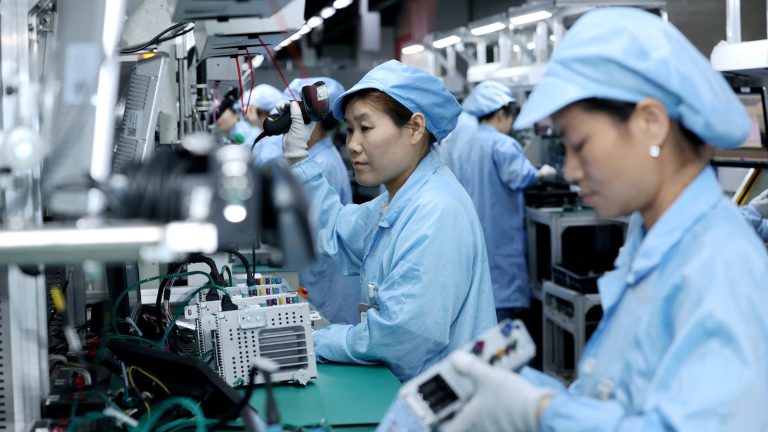It’s an argument President Donald Trump makes repeatedly as an end goal of his sweeping tariffs: America needs to bring companies and their manufacturing jobs — back to the U.S.
That’s a key reason, he says, that he imposed his hefty tariffs across the globe, with the heaviest levied on China, Vietnam and the European Union (although on Wednesday he put higher tariffs on some countries on pause — excepting China).
“Jobs and factories will come roaring back into our country,” Trump said last week in announcing his tariffs. “And ultimately, more production at home will mean stronger competition and lower prices for consumers.”
Making steel, aluminum and other products in the U.S. is a matter of national security, he added.
But on a practical level, experts say companies could take a long time to relocate, factories a long time to build and the cost of doing so — plus higher American labor wages — could make their products more expensive for American consumers.

Workers work on a production line manufacturing smart automotive central control navigation products at a factory of Beidou Intelligent Connected Vehicle Technology Co., in Suqian, Jiangsu Province, China April 9, 2025.
China Daily via Reuters
Trump has ‘fundamental misunderstanding’: Expert
Some economists and international trade experts told ABC News that the president’s controversial trade policy could actually discourage firms from setting up factories on American soil.
“Trump has a fundamental misunderstanding of how trade works. More domestic manufacturing does not mean a better economy,” Justin Wolfers, a professor of economics and public policy at the Gerald R. Ford School of Public Policy at the University of Michigan, told ABC News. “It’s an example I see a lot in 18-year-olds who turn up on the first day of my economics class.”
Wolfers and others contend that the decades of a U.S. shift from a manufacturing-heavy economy to one more based in financial and intellectual capital, tech and other white-collar fields, has done more to help American consumers and workers.
Wolfers said that Trump’s tariffs are a “solution looking for a rationale,” given the disparity between manufacturing and other sectors, which have attracted a lot of talent domestically.

A furnace belches a cloud of steam at the Thyssenkrupp steel mill, April 8, 2025 in Duisburg, Germany.
Sean Gallup/Getty Images
“One of the questions posed by the tariffs is should we undermine the competitiveness of the 140 million (non-manufacturing) jobs to satisfy the other 13 million (manufacturing)?” he said.
Layna Mosley, a professor of politics and international affairs at Princeton University, told ABC News that the “romanticizing” of America as a global manufacturing superpower ignores the fact that American companies have found ways to deliver top products in demand worldwide by spreading out the supply chain.
“There is an idea that the U.S. used to do a lot of things domestically and the reason we didn’t do that is that our economy has evolved,” she said.
Mosley noted that the components such as microchips and textiles are deeply rooted in international manufacturing markets because they have greater access to those materials.
“Oftentimes, there is no substitute available,” Mosley said.
A long time frame amid uncertainty
Even if companies do decide to abandon their international manufacturing sites and return to America, the economic experts said it will take an exceptionally long time for the American job market and consumers to benefit.
Trump himself admitted as much to reporters on Friday.
“Now, the good news is a lot of money for them, and they can build them fast, but they’re still very big plants. I’d always say it would take a year-and-a-half to two years,” he said.

President Donald Trump speaks at the National Republican Congressional Committee dinner in Washington, April 8, 2025.
Pool via AP
Wolfers contended that firms will likely not announce plans to set up their factories in the U.S. as long as the uncertainty and instability Trump has started continues.
“If I’m a firm, what matters to my decision to make a factory is not the tariff rate in 2025 but the tariff rate in 2028 and later,” he said. “These tariffs can easily be removed by Democrats or even other Republicans and by the time that factory is up and running, it might be a bad investment.”
Mosley warned that even if companies do announce plans, their grand plans may not come to fruition as envisioned.
“I can imagine a few firms that will announce a factory. They figure it curries favor with Trump and he will declare victory, but many firms won’t end up committing,” she said.
A situation like this played out during the Trump first term. In 2018, Trump touted a Foxconn plant in Wisconsin that would build flat panel screens and create 13,000 jobs and invest $10 billion.
“This is the eighth wonder of the world,” he boasted then at the announcement.
Three years later, following the pandemic and recession, Foxconn announced it was reducing its investment in the plant to $672 million and dropping its job numbers to roughly 1,400.
Mosely acknowledged that the appeal of blue collar jobs is strong for many Americans; however, she said the economic situation would make it difficult to bring back those jobs and workplaces.

Workers work on a production line manufacturing smart automotive central control navigation products at a factory of Beidou Intelligent Connected Vehicle Technology Co., in Suqian, Jiangsu Province, China April 9, 2025.
China Daily/via Reuters
James Anderson, the William B. Neenan, S.J. Millennium Professor in the Economics Department at the Boston College, told ABC News that even if the tariffs are fully overturned, the damage to America’s reputation as a strong economic nation has been tarnished and would deter firms from moving to the U.S.
“What has happened now is that its destroyed the trust in the United States and the destruction of that trust is a generational penalty,” he said.
Other countries have had better short-term solutions for those workers, such as paid vocational training and “more generous” unemployment options to help them transition to their new economies, according to Mosley.
“This is a massive political problem. The transition is not easy to make,” she said.
Long term, Wolfers said the U.S. can increase its investment into preparing and training younger generations into the economic sectors that are showing growth, such as tech, and making the country a worldwide leader.
“It’s bizarre to me we are trying to revive the economy of the 1950s when we are on the cusp of a major economic technical revolution,” he said.



